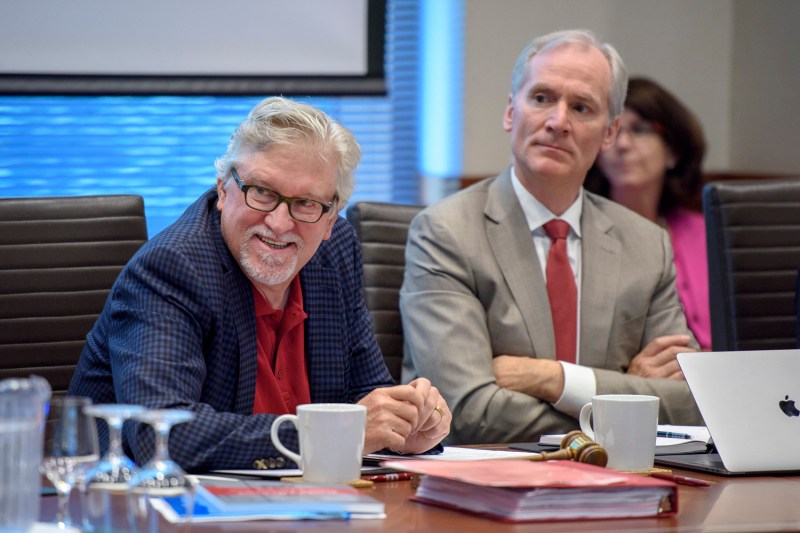Board of Trustees Chair Jeff Raikes ’80 spoke on the University’s ongoing long-range planning process, Budget Plan for the 2018-19 year, Bay Area affordability challenges and investment decisions — among other subjects that emerged in the Board’s meeting on last month.
Raikes described the University’s process to ascertain feedback on its long-range planning process from Stanford stakeholders as simultaneously inclusive and comprehensive. In early February, University leadership released 37 white papers — authored by four Area Steering Groups focused on Education, Research, Community and Engagement Beyond Our University — that synthesized more than 2,800 ideas submitted by members of the larger Stanford community.
“The trustees uniformly think that is a really valuable approach,” Raikes said. “We feel that this is a vision that sets important and compelling priorities of how Stanford can be purposeful about its future as well as its greater service to the broader world.”
University President Marc Tessier-Lavigne and Provost Persis Drell presented the high-level, long-range “vision” to Stanford’s Academic Council in May. University leadership resolved to appoint formal design teams to develop actionable plans for the set priorities, which range from increased faculty diversity and affordable housing to a need-blind admission policy for international applicants and ethical research initiatives.
“We hope the plan or sets of plans underneath that long-range vision come together over the next 12 to 24 months,” Raikes said.
During the meeting, Raikes said, the trustees approved Stanford’s $6.5 billion budget for the 2018-19 academic year. This year’s budget supports some of the more immediate goals present in the long-range planning vision. The University’s undergraduate financial aid program, for instance, will receive more support in the coming year, as will initiatives to fund community centers and increase faculty diversity on campus. The budget also includes additional funding for postdoc compensation and computing resources.
According to Raikes, Drell, who presented the budget, received “unanimous approval” from the Board.
Affordability, Raikes said, ranks as a “high priority issue” for University leadership. A task force on affordability, convened by Tessier-Lavigne, is currently charged with considering the issue and issuing recommendations by next spring. And as part of their meeting, the trustees took a tour of the University Terrace development, which aims to provide affordable housing for faculty members who are purchasing their first homes. The development includes 112 condominiums and 68 homes.
Raikes also emphasized that University Terrace stands as the result of “a very close working relationship” with the City of Palo Alto.
“This is an innovative approach for Stanford to address some of the challenges for faculty housing development,” he said.
In the midst of increased political polarization nationally, Raikes emphasized freedom of speech as a core value for Stanford going forward.
“I hope Stanford is a model and continues to grow as a model for having robust dialogue that gives people the benefit of multiple perspectives, and then in so doing, helps people to come together rather than to polarize,” Raikes said. “I think it is important for people to hear different points of view.”
Raikes said that this discourse is the “spirit” of Cardinal Conversations, the program Stanford launched last year that invites scholars with differing views to discuss a range of topics. The series has brought to campus controversial speakers like Charles Murray, who posits a relationship between IQ and race in his 1994 work “The Bell Curve.”
In early June, The Daily reported that Cardinal Conversations co-leader and Hoover Institution fellow Niall Ferguson encouraged Stanford College Republicans members over email to conduct “opposition research” on Michael Ocon ’20, a liberal ASSU Executive candidate who was involved in student efforts to reshape Cardinal Conversations. After the University became aware of the email chain, Ferguson resigned from his post as co-leader of the program.
Raikes said that he hopes the email exchange will not deter Stanford community members from valuing free expression.
“I think the University made it clear that those emails are not in keeping with the standards that the University upholds,” he said. “If you step back, I want everyone to continue to be focused on the need to promote free expression and inclusive community at Stanford. I hope that that unfortunate incident does not get in the way of that.”
The Board also heard a presentation on Stanford Medicine’s Integrated Strategic Plan. Stanford Medical School Dean Lloyd Minor, Stanford Health Care CEO David Entwistle and Lucile Packard Children’s Hospital Interim CEO Dennis Lund have worked together, Raikes said, to craft a “road map” for Stanford Medicine’s next decade.
According to Raikes, the strategic plan, which is aligned with the University’s overarching long-range planning process, emphasizes quality patient care and the use of data and digital technologies.
Reflecting on the integrated strategic plan, Raikes said Stanford Medicine’s unique partnership with the two hospitals allows research findings to be more readily applied in clinical contexts.
“This is the first time that the medical school and the two hospitals have teamed up to have a strategic integrated plan,” he said. “You’ve got this combination of Stanford’s ecosystem, with interdisciplinary, team-based science and education to accelerate discovery and the application of discovery. We think that it’s very important that we have this kind of integration.”
Tessier-Lavigne has previously cited the quickened application of research findings to better the world as an overarching priority of the University’s long-range planning process.
The Board approved the construction of a Center for Academic Medicine, a West Campus project set for completion in the summer of 2020.
Raikes also praised two outgoing Trustees, John Gunn ’65 M.B.A. ’72 and Chris Hazy, both of whom served on the board for 10 years.
Contact Courtney Douglas at ccdouglas ‘at’ stanford.edu
